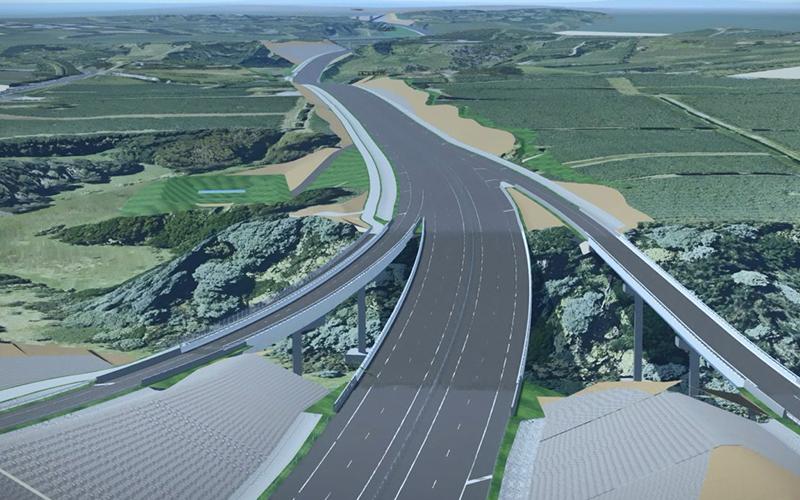Beca reduced the time to completion by 15% and improved design efficiencies by 20%.
Designing a road for a growing region
The western Bay of Plenty region in New Zealand, south of Auckland on the North Island, is one of the fastest-growing regions in the country. Growing traffic in the area, with many serious crashes, strained road systems. To improve safety, access, travel options, and to support economic development in the area, Waka Kotahi NZ Transport Agency initiated the Takitimu North Link project. This 14-kilometre, four-lane corridor and shared path will connect Tauranga and Ōmokoroa, improving safety and easing congestion. The government’s New Zealand Upgrade Programme (NZUP) has provided funding for the first stage of the project, 6.8 kilometres between Tauranga and Te Puna. The Fulton Hogan/HEB joint venture was awarded the design and construct contract, with Beca as their lead design consultant.
Beca’s road design includes various bridges and underpasses, a connection to existing roads, and bypass lanes. The area’s geology is largely volcanic in origin, but subsurface materials vary from fill, alluvial clays, silts and sands, weathered volcanic ashes, and sensitive Matua Subgroup tephras interbedded with ignimbrite. Groundwater levels are shallow in low-lying floodplains and deepen in the higher-elevation areas. These conditions presented challenges with stability, settlement, excavation, and varying pile foundation conditions.
Determining how to build sustainably
Given the complex conditions, traditional 3D design was not enough to meet the demands of the project. The development area was a very constrained corridor running through productive horticulture and farmland, limiting development options. As the design teams gathered and incorporated data, project needs and details greatly changed, requiring quick adaptation. Additionally, clear communication and collaboration with construction partners was key to reducing errors and minimising risk.
Beca also wanted to prioritise sustainability and construction efficiency as part of the New Zealand Upgrade Programme. “We are working hard to measure and benchmark a number of sustainable outcomes, including the project’s governance, procurement, carbon reduction, waste, environmental impacts, and, of course, community engagement,” said Ross Brown, technical director, civil, with Beca. As part of that effort, the company wanted to minimise the impact of development on existing properties as much as possible, even within the constrained footprint. Beca determined they needed an integrated, 3D model-based digital delivery approach, but they soon realised that not all applications could handle the complexity of the project or provide intuitive interdisciplinary collaboration.
Collaborating for rapid, optimised design
Beca determined they could transition to 3D modelling and digital delivery, as well as meet all project requirements with the help of Bentley applications. The organisation first established an open, connected data environment with ProjectWise, ensuring all information accessed by teams was always up to date and readily available, even during New Zealand’s particularly strict pandemic lockdown. Next, they used Leapfrog from Seequent, The Bentley Subsurface Company, to create 3D models of the ground conditions to inform road and drainage design, earthworks, and structure design, as well as to optimise and model volumes for the mass haul of fill material. With clear knowledge of ground conditions, they determined how to make the most of ground cuts in the volcanic ash layer, as it was the strongest material and could be cut to a steeper slope.
Then, designers used MicroStation, OpenBridge, and OpenRoads to establish a model-based approach for designing road elements. The road team quickly made changes as designers received new requests and determined how to improve the road alignment. At the same time, the bridge design team could keep up with the rapid road changes and adjust the bridge models without adversely affecting their design, as bridge models were linked to the road alignment model. With the iTwin Platform, they unified all elements into a single digital model accessible by all stakeholders. Lastly, to present their work to the tender evaluation team and keep them informed of any changes, they created an animated presentation with LumenRT to provide an immersive view of the proposed designs. “Option selection during the tender phases needed quick, realistic visualisation so that the designers, constructors, and the client could understand the evolving plan,” Brown said.
Improving efficiency and saving significant costs
By using 3D design and enabling close coordination between teams, Beca reduced the time to completion by 15% and improved the quality of the deliverables. As one example of the benefit of digital collaboration, the drainage team switched from an unconnected third-party application to OpenRoads Designer, enabling them to work together with the team designing the road and incorporate automatic updates, leading to productivity gains of over 15%. Modelling eight of the bridges within OpenBridge resulted in significant savings compared to previously used methods. The streamlined workflows allowed teams to consider more options, which reduced tender costs and improved design efficiencies by 20%.
By optimising the horizontal and vertical alignment of the road in a 3D design environment, Beca was able to completely eliminate the impact of construction on two properties and lower the impact on several others, which will save significant construction time and cost. Having detailed geological insight will allow the construction team to reuse all excavated material, eliminating the need to use heavy equipment to remove material or import fill to the site. The design will eliminate 22,000 truck movements during construction, equivalent to 900,000 kilometres of travel, lowering carbon emissions by 560 tons. The project is now under construction, and Beca anticipates the more accurate design will greatly reduce the amount of rework needed. Beca is also exploring how their model could be used to support maintenance after construction.






